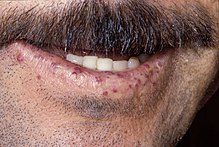User:Mr. Ibrahem/Hereditary hemorrhagic telangiectasia
| Hereditary hemorrhagic telangiectasia | |
|---|---|
| Other names | Osler–Weber–Rendu disease, Osler–Weber–Rendu syndrome |
 | |
| Characteristic lip telangiectases. | |
| Specialty | Medical genetics, gastroenterology |
| Symptoms | Telangiectasias, nosebleeds, gastrointestinal bleeding[1] |
| Complications | Arteriovenous malformations, iron deficiency anemia[1] |
| Usual onset | 12[1] |
| Types | Type I to V[2] |
| Causes | Genetic disorder[1] |
| Diagnostic method | Based on symptoms, genetic testing[1] |
| Differential diagnosis | Spider angioma, ataxia–telangiectasia, Bloom syndrome, CREST syndrome[1] |
| Treatment | Nasal packing, surgery, iron supplements[1] |
| Prognosis | Life expectancy almost normal[2] |
| Frequency | 1 in 6,500 people[3] |
Hereditary hemorrhagic telangiectasia (HHT) is a genetic disorder that leads to abnormal blood vessels in the skin and mucous membranes.[3][4] This results in multiple telangiectasias; which, when they bleed may result in nosebleeds or digestive tract bleeding and iron deficiency anemia.[1] Onset of symptoms is often around the age of 12.[1] Other complications may include arteriovenous malformations (AVMs) of the lungs, liver, or brain.[1]
HHT is transmitted in an autosomal dominant fashion.[3][4] The underlying mechanism involves disruption of the TGF beta signaling pathway leading to fragile blood vessels.[1] Diagnosis may be confirmed in those with recurrent nosebleeds, telangiectasias, and an affected first-degree relative or by genetic testing.[1] Screening for AVMs with medical imaging is recommended in those affected.[1]
Nosebleeds may be treated with packing.[1] Surgery or other targeted interventions may be required to treat AVMs of the lungs, brain, liver, or digestive tract.[1] Chronic bleeding often requires iron supplements and sometimes blood transfusions.[1] Life expectancy is almost normal.[2]
HHT occurs in about 1 in 5,000–8,000 people.[3] Males and females are affected with similar frequency.[2] Henry Gawen Sutton first identified the condition in 1864.[2] The disease was subsequently named of Sir William Osler, Henri Jules Louis Marie Rendu, and Frederick Parkes Weber, who described it in the late 19th and early 20th centuries.[5]
References[edit]
- ^ a b c d e f g h i j k l m n o p Macri, A; Wilson, AM; Shafaat, O; Sharma, S (January 2021). "Osler-Weber-Rendu Disease". PMID 29493983.
{{cite journal}}: Cite journal requires|journal=(help) - ^ a b c d e "Hereditary Hemorrhagic Telangiectasia". NORD (National Organization for Rare Disorders). Retrieved 3 March 2021.
- ^ a b c d Govani FS, Shovlin CL (July 2009). "Hereditary haemorrhagic telangiectasia: a clinical and scientific review". European Journal of Human Genetics. 17 (7): 860–71. doi:10.1038/ejhg.2009.35. PMC 2986493. PMID 19337313.
- ^ a b Dupuis-Girod S, Bailly S, Plauchu H (March 2010). "Hereditary hemorrhagic telangiectasia (HHT): from molecular biology to patient care". J. Thromb. Haemost. 8 (7): 1447–56. doi:10.1111/j.1538-7836.2010.03860.x. PMID 20345718.
- ^ Fuchizaki U, Miyamori H, Kitagawa S, Kaneko S, Kobayashi K (November 2003). "Hereditary haemorrhagic telangiectasia (Rendu–Osler–Weber disease)". Lancet. 362 (9394): 1490–4. doi:10.1016/S0140-6736(03)14696-X. PMID 14602446. S2CID 5304256.
